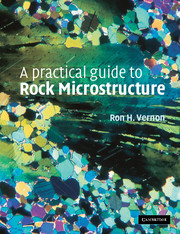Book contents
1 - Background
Summary
Introduction
I wrote this book to help you to interpret what you see when you look at thin and polished sections of rocks with the microscope. I say ‘help’, rather than ‘teach’, because I don't want to give the impression that every microstructure you see can be easily and unambiguously interpreted in terms of processes that produced the rock. Many can, but in many other instances, conventional interpretations are ambiguous or poorly understood. So I intend the book to be only a guide, and I present alternative ideas where appropriate. A healthy scepticism should be maintained when interpreting rock microstructures yourself and also when reading the interpretations of others
History of the examination of rocks with the microscope
Rocks in natural outcrops, in samples knocked off these outcrops and in drill cores, are beautiful and instructive. We can see different minerals, and identify many of them with the aid of a hand lens. We can also see some of the more obvious structures in the rocks. However, cutting a slice (section) though a rock with a diamond-impregnated circular saw and polishing the sawn surface shows us the various minerals alongside each other, rather than piled confusingly all around each other. This reveals the structure even more clearly, as can be seen in the polished facing slabs on many buildings and bench tops.
- Type
- Chapter
- Information
- A Practical Guide to Rock Microstructure , pp. 1 - 12Publisher: Cambridge University PressPrint publication year: 2004



